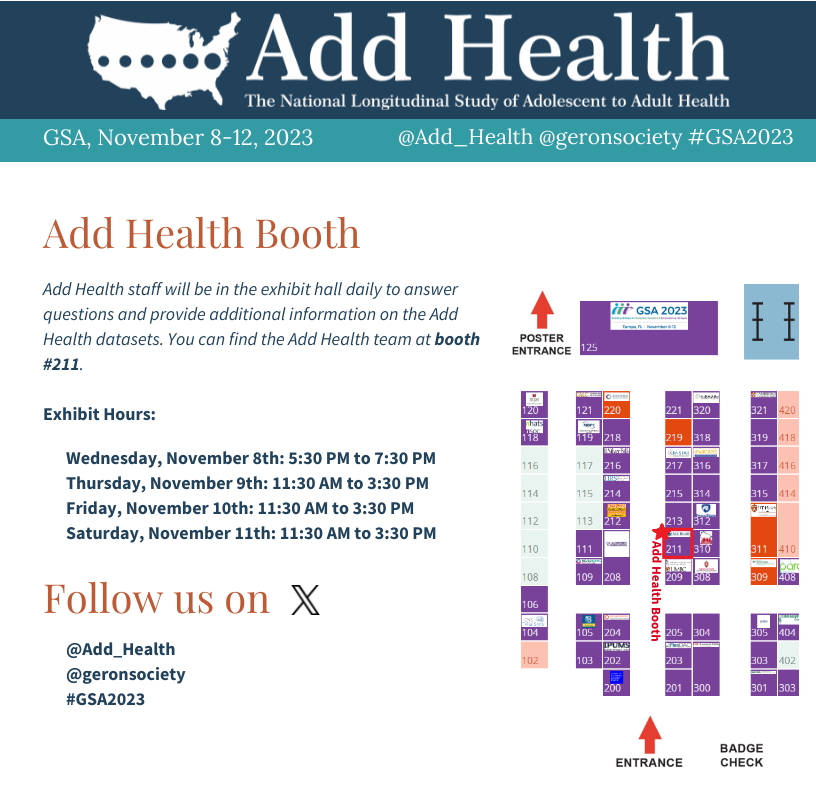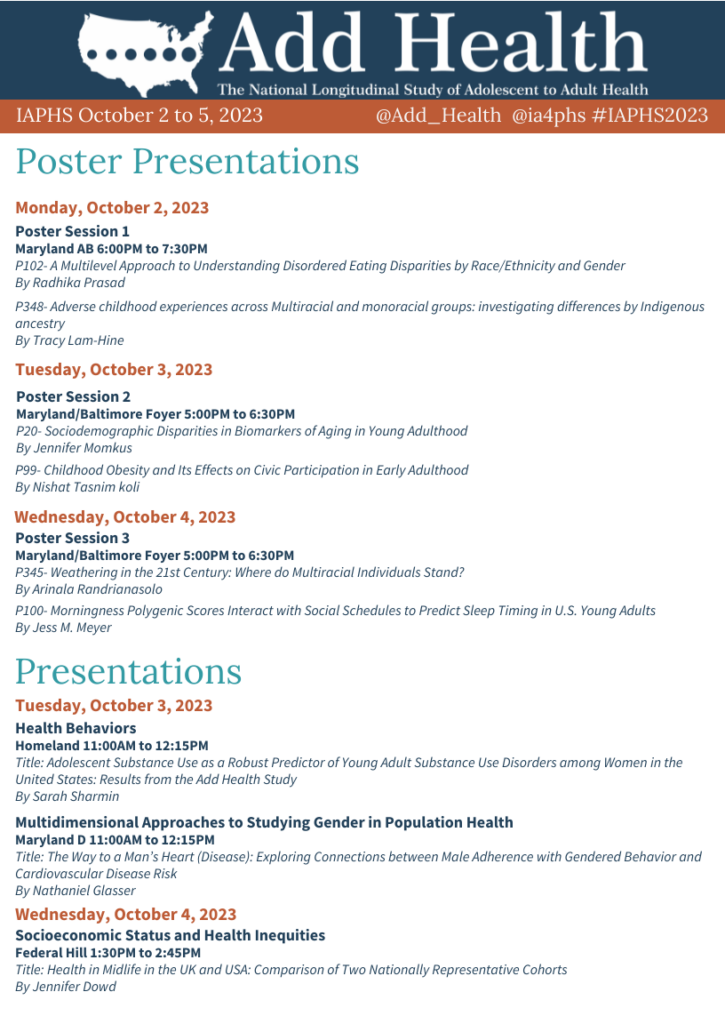Add Health is excited to be attending the Society for Epidemiological Research 2023 Conference in Portland, Oregon, on Tuesday, June 13th to Friday, June 16th. Come by the exhibit hall where Add Health staff with be at booth #4 and be sure to check out the following posters using Add Health Data:
Poster Session 1, Health Disparities
Tuesday, June 13, Exhibit Hall
7:30 PM to 8:30PM
P-596. Comparing lifetime polyvictimization and mental health outcomes in women with vs without incarceration histories: A population based latent class analysis Sandra P. Arevalo, PhD* [57496] Arevalo Qianwei Zhao
Purpose: This study uses data from the Add Health, a national and longitudinal survey, to identify women with (n = 418) and with no incarceration histories (n = 5,099) to compare lifetime trauma exposure and risk for distal mental health and substance use outcomes in women with vs. without incarceration histories. Method: With a detailed list of traumas that captures the category (e.g., sexual, physical, psychological), the perpetrator (parent, partner, other), and timing (e.g., childhood, adolescence, adulthood) of the exposure, we used Latent Class Analysis to identify distinct groups of polytrauma exposure in the two groups of women. Multivariate logistic regressions examine the association between class membership and mental health (depressive symptomatology, PTSD, anxiety, suicidal ideation, and suicide attempt), and substance misuse (alcohol, marijuana, and other illicit drug misuses) outcomes, after adjusting for relevant covariates. Results: we identify a unique pattern of trauma exposure characterized by high exposure to multiple types of childhood abuse that persisted during the preschool and middle childhood years in the group of women with incarceration histories. Different groups of polytrauma exposure were associated with distinctive mental health and substance misuse outcomes among women with incarceration histories, but not in women without incarceration histories. Conclusion: Our findings highlight the common prevalence of polyvictimization exposure in both women with and without histories of incarceration; and point to distinct patterns created by the type, frequency, and timing of the trauma exposure, and their distinct associations to distal psychological health outcomes, and possibly criminal justice involvement.
Poster Session 1, Neurology
Tuesday, June 13, Exhibit Hall
7:30 PM to 8:30 PM
P-959. Evaluating Pathways between Dementia Risk Factors, Biomarkers of AD/ADRD, and Cognitive Function in Young Adulthood. Jennifer Momkus* [57496] Aiello Jennifer Momkus Rebecca Stebbins Yuan Zhang Y. Claire Yang Kathleen Mullan Harris
Background: The Cardiovascular Risk Factors, Aging, and Incidence of Dementia (CAIDE) risk score has shown significant predictive value for AD and cognitive impairment in older age populations. Yet, it is increasingly recognized that neuropathology and cognitive decline begin much earlier, including during young adulthood. Thus, there is a need to examine the utility of risk scores for AD in younger adult populations. We tested the association of the CAIDE score in predicting cognitive function in young adults and assessed whether the score was associated with biomarkers of AD/ADRD risk in young adulthood. Methods: Participants were from Wave IV (ages 24-34) and Wave V (ages 33-44) of the National Longitudinal Study of Adolescent to Adult Health (Add Health). The CAIDE score was constructed based on survey and physical exam data using age, educational attainment, sex, systolic blood pressure, BMI, total cholesterol, and physical activity. Measures of word recall and digit span backwards tasks were used to assess cognitive function. We used survey-weighted linear regression to estimate the associations between CAIDE score and (1) cognitive function (2) biomarkers of inflammation and neurological damage at each wave (including C-Reactive Protein (CRP), Interleukin (IL)-6, total Tau, Neurofilament light, among others), adjusting for race/ethnicity and early life socioeconomic status (SES). Results: A higher CAIDE score at Wave IV was associated with lower cognitive function at Wave IV and Wave V (see Figure 1). A higher CAIDE score was also associated with higher levels of CRP and IL-6 in both waves. Neither the Wave IV nor Wave V CAIDE score predicted markers of neurodegeneration. Conclusions: Even in early adulthood, known dementia risk factors were associated with cognitive function. Chronic inflammation may play a role in this relationship. Intervention earlier in the life course may be especially effective for prevention of AD/ADRD.
Poster Session 2, Cardiovascular
Wednesday, June 14, Exhibit Hall
6:30 PM to 7:30 PM
P- 244. Adverse Childhood Experiences and Hypertension Risk in Adulthood: Results from Wave V of the Add Health Study. Fahad Mansuri* [57496] Mansuri Megan C. Barry Jill Desch Dieu Tran Skai Schwartz Chighaf Bakour
Background and objective: The impact of the clustering of multiple adverse childhood experiences (ACEs) on hypertension in adulthood has not been adequately explored. We examined the association of ACEs with hypertension and assessed sex and race as effect modifiers using data from the National Longitudinal Study of Adolescent to Adult Health (Add Health). Methods: We used data from Waves I, III, IV, and V of the Add Health study. An ACE score (range: 0-9) variable indicating the total number of ACEs experienced out of the nine ACEs (physical, sexual, and emotional abuse; neglect; parental incarceration, alcoholism, divorce/separation; foster home placement; and exposure to community violence) was created and split into five categories of 0, 1, 2, 3, and 4 or more ACEs. Hypertension was defined as: SBP≥130 mm/Hg and/or DBP≥90 mm/Hg; taking an antihypertensive medication; and/or self-reported diagnosis of hypertension. The association between ACE score and hypertension was examined using multivariable regression analysis. Interaction terms for race and sex were included in models to examine the effect modification and the models were adjusted for participant’s sex; race; age, household income, and parental education at Wave I. Results: The final sample included 5,157 participants with a mean age of 15 years at Wave I and 37 at Wave V. About 50% of the participants were female and 17% of the participants were African American. The risk of hypertension (Wave V) in participants with 0, 1, 2, 3, and 4 or more ACEs was 37.6%, 39.3%, 44.8%, 42.7% and 41.1% respectively. The adjusted RR (95% CI) of hypertension in the participants with 1, 2, 3, 4 or more ACEs (vs. 0 ACE) was 1.0 (0.9, 1.2), 1.1 (0.9, 1.3), 1.1 (0.9, 1.3), and 0.9 (0.8, 1.2) respectively. Likewise, the adjusted RD (95% CI) of hypertension in the participants with 1, 2, 3, 4 or more ACEs (vs. 0 ACE) was -0.05 (-5.2, 5.1), 4.4 (-1.7, 10.4), 2.8 (-4.8, 10.4), and -1.52 (-9.4, 6.4) respectively. There was no evidence of interaction of sex and race with ACEs score on the multiplicative or additive scales. Conclusion: Using data from the Add Health study, we found that experiencing higher number of ACEs was not associated higher risk of hypertension in adulthood. We also found no evidence of effect modification of the association between ACEs and hypertension by sex or race.
Poster Session 2, Perinatal & Pediatric
Wednesday June 14, Exhibit Hall
6:30 PM to 7:30 PM
P- 1096. Upward mobility is associated with preterm birth but not low birthweight. Julia M Porth* [57496] Porth Bobby K Cheon
Background: Changes in socioeconomic status (SES) between adolescence and adulthood, termed SES mobility, may influence perinatal health via changes in resources available to engage in healthy behaviors, stress, and psychological strain due to changing status. This analysis examined relationships between SES mobility and women’s experiences of delivering a child who is preterm (PTB) or has a low birthweight (LBW). Methods: Data came from the National Longitudinal Study of Adolescent to Adult Health. SES was defined as a combination of education, occupation, and income, assessed among parents (when participants were aged 12-19) and later in adult participants (aged 24-32). SES mobility was the difference between parent and adult SES quintile, categorized as short-range (adult SES 1 quintile higher/lower than parent SES) and long-range (adult SES 2-4 quintiles higher/lower than parent SES). Those who did not experience SES mobility were categorized as having high SES immobility or low SES immobility. Relationships were assessed using logistic regressions accounting for complex survey design and clustering of births by mother. Results: Samples included 1,041 births from 672 mothers (PTB) and 1,013 births from 655 mothers (LBW). Compared to high SES immobility, upward mobility was associated with higher odds of PTB (OR: 2.77 [95% CI: 1.26, 6.08]), results which seem to be largely driven by short-range upward mobility (OR: 2.78 [1.28, 6.03]). Odds of PTB were higher among downwardly mobile participants though the 95% CI contained the null (OR: 1.82 [0.82, 4.03]). Neither upward nor downward mobility were associated with odds of LBW. Conclusions: Contrary to previous studies using more geographically restricted samples, results of the present study suggest upward mobility may be associated with increased odds of PTB. Future research should seek to clarify specific groups in which upward SES mobility can be harmful to perinatal health.












